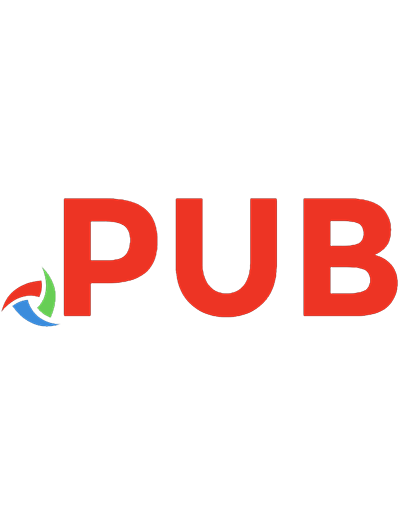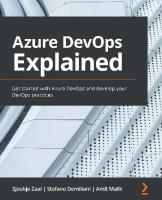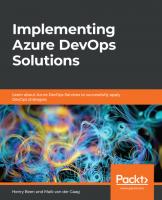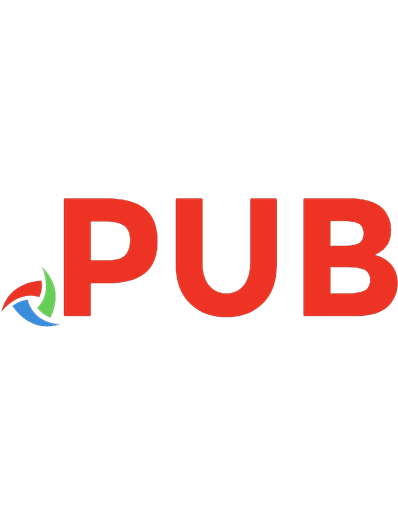Azure DevOps Explained: Get started with Azure DevOps and develop your DevOps practices 1800563515, 9781800563513
Developing applications for the cloud involves changing development methodologies and procedures. Continuous integration
1,457 322 38MB
English Pages 438 Year 2020

- Author / Uploaded
- Sjoukje Zaal
- Stefano Demiliani
- Amit Malik
- Categories
- Computers
- Networking: Internet
- Commentary
- true epub
Table of contents :
Cover
Copyright
About PACKT
Contributors
Table of Contents
Preface
Section 1: DevOps Principles and Azure DevOps Project Management
Chapter 1: Azure DevOps Overview
Introducing DevOps
Understanding DevOps principles
Principle 1 – Customer-centric action
Principle 2 – Create with the end in mind
Principle 3 – End-to-end responsibility
Principle 4 – Cross-functional autonomous teams
Principle 5 – Continuous improvement
Principle 6 – Automate everything
Introducing Azure DevOps key concepts
Plan
Develop
Deliver
Operate
Continuous integration and continuous delivery (CI/CD)
Agile development support
Version control
Infrastructure as Code
Configuration Management
Monitoring
Discovering Azure DevOps services
Azure Boards
Azure Repos
Azure Pipelines
Azure Test Plans
Azure Artifacts
Extension Marketplace
Introducing the scenarios
Creating the starter project
Summary
Further reading
Chapter 2: Managing Projects with Azure DevOps Boards
Technical requirements
Understanding processes and process templates
Creating an organization
Creating a project
Creating and managing project activities
Work Items
Backlogs
Boards
Sprints
Queries
Summary
Further reading
Section 2: Source Code and Builds
Chapter 3: Source Control Management with Azure DevOps
Technical requirements
Understanding SCM
Exploring branching strategies
GitHub Flow
GitLab Flow
Git Flow
Handling source control with Azure DevOps
Cloning a remote repository
Importing a GitHub repository into Azure DevOps
Working with commits, pushes, and branches
Protecting branches with policies
Cross-repo policies
Working with pull requests
Creating a pull request from the Azure DevOps pull request page
Creating a pull request from a work item
Creating a pull request after pushing a branch
Creating a pull request from Visual Studio Code or Visual Studio
Handling a pull request
Tagging a release
Summary
Chapter 4: Understanding Azure DevOps Pipelines
Technical requirements
Implementing a CI/CD process
Overview of Azure Pipelines
Understanding build agents
Microsoft-hosted agents
Self-hosted agents
When to use a Microsoft-hosted or a self-hosted agent
Overview of the YAML language
Scalars
Collections and lists
Dictionaries
Document structure
Complex object definition
Creating a build pipeline with Azure DevOps
Pipeline definition with the classic editor
YAML pipeline definition
Retention of builds
Multi-stage pipeline
Building a pipeline with GitHub repositories
Executing jobs in parallel in an Azure Pipeline
Agents on Azure Container Instances
Using container jobs in Azure Pipelines
Summary
Chapter 5: Running Quality Tests in a Build Pipeline
Technical requirements
Benefits of automatic testing
Introduction to unit testing
Running unit tests in a build pipeline
Downloading the source code
Creating the pipeline
Introduction to code coverage testing
Performing code coverage testing
Assigning test results to work items
Introduction to Feature Flags
Using Feature Flags to test in production
Creating a new .NET Core application
Summary
Further reading
Chapter 6: Hosting Your Own Azure Pipeline Agent
Technical requirements
Azure pipeline agent overview
Understanding the types of agents in Azure Pipelines
Microsoft-hosted agents
Self-hosted agents
Planning and setting up your self-hosted Azure pipeline agent
Choosing the right OS/image for the agent VM
OS support and pre-requisites for installing an Azure Pipelines agent
Creating a VM in Azure for your project
Setting up the build agent
Updating your Azure pipeline to use self-hosted agents
Preparing your self-hosted agent to build the Parts Unlimited project
Running the Azure pipeline
Using containers as self-hosted agents
Setting up Windows containers as Azure pipeline agents
Setting up Linux containers as Azure Pipelines agents
Using Azure Container Instances as agents
Environment variables
Planning for scale
Creating an Azure VM scale set
Setting up Azure pipeline agents with VM scale set
Summary
Section 3: Artifacts and Deployments
Chapter 7: Using Artifacts with Azure DevOps
Technical requirements
Introducing Azure Artifacts
Creating an artifact feed with Azure Artifacts
Producing the package using a build pipeline
Adding the sample project to the PartsUnlimited repository
Creating the build pipeline
Publishing the package to the feed from a build pipeline
Setting the required permissions on the feed
Consuming the package in Visual Studio from the Artifacts feed
Scanning for package vulnerabilities using WhiteSource Bolt
Summary
Further reading
Chapter 8: Deploying Applications with Azure DevOps
Technical requirements
An overview of release pipelines
Creating a release pipeline with Azure DevOps
Creating the Azure DevOps release
Configuring the release pipeline triggers for continuous deployment
Creating a multi-stage release pipeline
Using approvals and gates for managing deployments
Creating approvals
Using gates to check conditions
Using deployment groups
YAML release pipelines with Azure DevOps
Summary
Section 4: Advanced Features of Azure DevOps
Chapter 9: Integrating Azure DevOps with GitHub
Technical requirements
An overview of Azure DevOps and GitHub integration
Integrating Azure Pipelines with GitHub
Setting up Azure Pipelines and GitHub integration
Testing continuous integration
Adding a build Status badge
Integrating Azure Boards with GitHub
Setting up Azure Boards and GitHub integration
Adding an Azure Boards Status badge
Linking Azure Boards work items to GitHub objects
Updating work items from GitHub
Overview of GitHub Actions
Summary
Chapter 10: Using Test Plans with Azure DevOps
Technical requirements
Introduction to Azure Test Plans
Exploratory testing
Installing and using the Test & Feedback extension
Planned manual testing
Test plans, test suites, and test cases
Managing test plans, test suites, and test cases
Running and analyzing a manual test plan
Summary
Further reading
Chapter 11: Real-World CI/CD Scenarios with Azure DevOps
Technical requirements
Setting up a CI/CD pipeline for .NET-based applications
Introduction to the sample application
Preparing the pre-requisite Azure infrastructure
Setting up an Azure DevOps project
Setting up a CI/CD pipeline for a container-based application
Introduction to the sample app
Setting up the required infrastructure
Setting up Azure Repos for the voting application
Setting up the CI pipeline
Setting up the CD pipeline
Simulating an end-to-end CI/CD experience
Azure Architecture Center for DevOps
Summary
Other Books You May Enjoy
Index




![Azure DevOps Server 2019 cookbook : proven recipes to accelerate your DevOps journey with Azure DevOps Server 2019 (formerly TFS) [Second edition.]
9781788839259, 1788839250](https://dokumen.pub/img/200x200/azure-devops-server-2019-cookbook-proven-recipes-to-accelerate-your-devops-journey-with-azure-devops-server-2019-formerly-tfs-second-edition-9781788839259-1788839250.jpg)

![Azure DevOps for Web Developers: Streamlined Application Development Using Azure DevOps Features [1st ed.]
9781484264119, 9781484264126](https://dokumen.pub/img/200x200/azure-devops-for-web-developers-streamlined-application-development-using-azure-devops-features-1st-ed-9781484264119-9781484264126.jpg)


